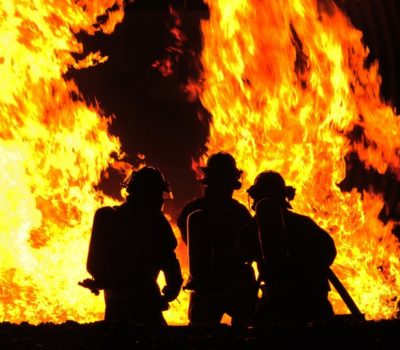The A-F Of Fire Classes
There are many different classes of fire and each fire requires different kinds of fire extinguishing methods and tools. Understanding the difference between them could help save lives, save money, and prevent property damage – especially if a fire is in the workplace.
So what are the different classes of fire and how can you fight them?

Class A – Ordinary Combustible Fires
This is the most common kind of fire with the materials involved in an ordinary fire being things like paper, rubber, wood, and textiles. Ordinary combustible fires occur when fuel is heated and ignited. They’ll continue to burn if there is a supply of oxygen and ample fuel but they are also the easiest to fight as they can be extinguished with water which cools the fire down until it cannot stay alight.
Fire Extinguishers For Class A Fires: It’s best to use either water- or foam-based extinguishers to put out a class A fire.
Class B – Flammable Liquid Fires
Petrol, alcohol, paints, solvents, and kerosene are all examples of common flammable liquids. Flammable liquid fires are extremely hot and spread very quickly. They also produce toxic black smoke that makes them particularly deadly and very hard to fight.
Fire Extinguishers For Class B Fires: Foam fire extinguishers are the best option for flammable liquid fires as they suffocate the flames. Do not use water to fight this kind of fire as it splashes and scatters the liquid fuel, spreading the fire further.
Class C – Flammable Gas Fires
Common flammable gases are propane, butane, and different petroleum gases. The lower explosive limit (LEL) is the minimum concentration of flammable gas in the air that might explode if ignited. For most flammable gases, the LEL is just 5%, making them incredibly dangerous if mismanaged. For flammable gas fires, it is always best to ensure that the gas supply has been cut off before you even attempt to fight the flames. Otherwise, you could be walking into a large explosion.
Fire Extinguishers For Class C Fires: Whilst most fire extinguishers are ineffective at extinguishing flammable gas fires, dry powder extinguishers can be effective.

Class D – Metal Fires
It usually requires a significant amount of heat to ignite metals because they are very good conductors and transfer heat away quickly and efficiently. However, metal powder or metal shavings are much easier to ignite as they do not conduct heat as well. Some metals such as sodium, aluminium, magnesium, and potassium actually burn when they come into contact with water and air, so water and foam fire extinguishers are out of the question and may cause a violent explosive reaction. If there’s a large amount of burning metal, it’s probably best to let it burn out naturally as metal fires produce a lot of ash that usually starves the fire of oxygen after a while.
Fire Extinguishers For Class D Fires: If you spot a metal fire early enough, then a powder fire extinguisher will work, but only if it is the dry power variety – the other variety will make matters worse.
Class E – Electrical Fires
Class E fires are fuelled by electrical appliances such as TVs, computers and hair dryers. Extinguishing them can be difficult and very dangerous if you don’t know what you’re doing.
Before you even think about extinguishing an electrical fire, it is important to turn off the source of electricity to the fire. Don’t use water or foam-based extinguishers on electrical fires even when the electricity source has been cut off. Instead, use dry powder and carbon dioxide fire extinguishers as they’ll starve the fire of oxygen without running the risk of conducting electricity.
Fire Extinguishers For Class E Fires: The appropriate extinguishers used to tackle a class E fire include CO2 gas or a dry powder extinguisher.
Class F – Cooking Oil Fires
Cooking oil fires are very common in both homes and commercial kitchens. One of the worst things you can do is use water or a water-based fire extinguisher to try and fight the flames. The water is more likely to scatter the oil, causing the fire to spread even faster and cause the hot oil to splatter in all directions.
Wet chemical extinguishers have a special formula that cools down the cooking oil and also emulsifies so that the surface of the cooking oil is sealed, stopping oxygen from getting at it, thus preventing reignition.
Fire Extinguishers For Class F Fires: Specialist wet chemical extinguishers have been developed to help fight cooking oil fires.
Our Fire Curtains Work On All Fire Classes

Regardless of the kind of fire, they all work the same way with three different components; fuel, heat, and oxygen. It’s the type of fuel involved that changes the class of fire that you’re dealing with.
Our fire curtains and fire shutters work by preventing the fire spreading into the next room, finding more fuel and a fresh oxygen source.
If you’re interested in our expert advice or further information about our services, please don’t hesitate to get in touch.




